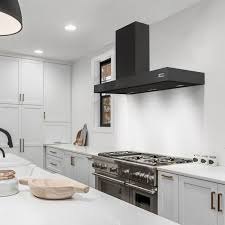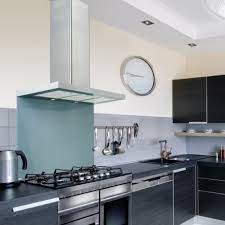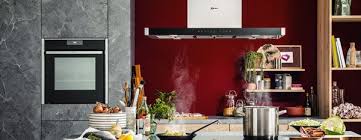
Extractor hood for Gurgaon Kitchens
Nowadays, it is inconceivable to set up a kitchen without including an exhaust fan. It is essentially a part of a functional nature, but which now arises with a design increasingly appealing not clash with the whole that is the kitchen. It is, therefore, an appliance that combines convenience with aesthetics. Proof of this are the kitchen hoods that illustrate this book of ideas.
The hood has the primary function of removing odors from the kitchen, helping to keep it clean. Furthermore, they free the environment from the fumes that are generated when cooking. At the same time, and increasingly, they are becoming the focal point of the space as an extension of the style and taste of the owners.
If you are in the process of equipping your kitchen or if you just want to replace your old cooker hood with a new one, then this article is for you. Find out more about this very important device to purify the air in the kitchen – and, subsequently, in the home – and make the use of this room more comfortable.
What is an exhaust fan and what is it for?
First of all, it is useful to clarify concepts. What, after all, is an exhaust fan? What functions does this appliance perform?
Now, the hood is a device that eliminates stale air – that is, the previously fresh air that has become impure – fumes, vapors and bad smells. It is, as a rule, used in kitchens – private and industrial -, although it can also appear indoors. This air treatment takes place by means of exhaustion – hence the name – or purification of gases.
The hood must be placed on a stove and oven in a kitchen to immediately evacuate the impure air and fats they produce. The absence of an extractor hood, in addition to the harmful effects it has on the kitchen air, leads to its surfaces quickly becoming dirty and greasy.
The suction systems of the hoods are divided between the evacuation and the recirculation systems. The first one transports the air from the kitchen, filters it and takes it outside. The recirculation system, as can be seen from the name, returns filtered and clean air to the kitchen, that is, it does not expel it outside.

What should you take into account before buying a hood?
Yes, it is true: there is a whole science in this thing of buying an exhaust fan. Ponder the following points:
- Cost: as always, price is a point to consider. Most people are guided by a budget, so it is advisable to analyze several options and reach conclusions based on the quality-price ratio. There are extremely sophisticated hoods, but there are also simple and reliable units that perfectly serve a standard kitchen. There are several factors that can make the hood more expensive, such as digital controls, the fact that they have quiet engines, the design , among others.
- Power: the power of an exhaust fan is measured by the cubic meters of air that it cleans in an hour. Calculate the power of the hood depending on the size of the kitchen. The hood must absorb air between six and eight times the volume of the space.
- Noise: the noise produced by the hood is one of the main disadvantages of this appliance. There are times when it becomes so exhausting, that we close it and forget the issue of fumes and odors! The more decibels the hood has, the more noise it will generate. The good news is that, in modern exhaust fans, the noise can already be adjusted and there are even silent exhaust fans. In addition, you can choose an exhaust fan without a motor (hood) or mount the motor outside the space. A level below 60 decibels is best for the kitchen.
- Energy consumption: for the sake of the planet, opt for an exhaust fan that belongs to an efficient class. You can see the class of appliances on the energy label attached to them. Equipment covered by energy class A +, A ++ or A +++ leads to an average savings of approximately 20%, 40% and 60% compared to class A. As far as the hood filters are concerned, you can also make a choice more ecological. In the case of a model that uses disposable filters, favor a model with permanent metal filters that can be washed by hand or placed in the dishwasher.
- Aesthetics: efficiency is everything, but if the extractor hood fits into the kitchen harmoniously, valuing it from the aesthetic points of view, so much the better.
What types of hoods are there?
In addition to the characteristics mentioned above, it is important to take into account the types of hoods that exist.
Are they:

- Integrated hoods: they are the most popular on the market. They appear mounted under the upper cupboard, which in turn is on the stove. The pipes of these hoods are, as a rule, inserted into the adjoining wall or ceiling. Some are fixed, others can be pulled, sliding forward and thus covering a larger exhaust area.
- The wall chimney hoods: if there are no upper cabinets, you can choose to install a wall hood. In this case, the pipes are connected directly to the outside, speeding up the ventilation of the space.
- Island chimney hoods: kitchen islands are in fashion and stoves are often incorporated into them. In this way, the hood has to be placed on the ceiling in order to empty onto the stove. This extractor extracts the fumes through a chimney in the ceiling.
- Extractors without pipes: the fumes are directed away from the stove, but not expelled from the kitchen. However, this type of extractor filters oil and other particles, releasing fresh air and with less odors.
How to install the hood?
We suggest that you consult with the manufacturer or your kitchen designer if you are being accompanied by this professional in the design of your kitchen. Exhaust fans are usually installed between 45 and 75 centimeters above the heat sources. Remember that you must continue to have space for cooking, but at the same time, prevent vapors and fumes from escaping from the sides.
In order to optimize the air filtration, remember to replace or wash the filters and keep an open connection with the outside to maximize the air flow.
Bathroom hoods or bathroom extractors: what they are, what types exist and what power they need
The bathrooms are small spaces with high levels of humidity. It is therefore essential to install a bathroom extractor (the word extractor is used more than an exhaust fan when referring to a bathroom). It is a small electrical device that is installed on the ceiling to ventilate and ventilate the room. The existence of a bathroom extractor also prevents the formation of mold and keeps walls, ceilings and joints in good condition for longer.

5.1. What types of bathroom extractors are there?
Bathroom extractors can be distinguished in two types: axial and centrifugal.
The axial extractors are placed on the ceiling and are suitable for reduced duct installations. Helicopters – which are installed on windows or exterior walls without evacuation ducts – fall into this group.
Centrifugal extractors are more powerful than the previous ones, so they adapt to installations where the evacuation ducts are longer (up to 50m).
Bathroom extractors can be activated manually (via a switch), by presence detection (when someone enters the space), by the humidity level (they turn on automatically when the environment is very humid) and by timer (they turn off after the time necessary to renew the air).
5.1. Wattage
Obviously, the power does not need to match that of kitchen hoods since it is a smaller space. In the bathroom, the power of the extractors ranges from 8 to 35 watts. The more powerful the engines, the greater the noise level.
Industrial extractor fan
As the name suggests, the industrial hood designates an industrial ventilation device that is essential to preserve air quality in an industrial environment.
Like home and kitchen or bathroom hoods, they are also responsible for renewing the air and providing a comfortable and breathable air for those who work in places dedicated to the chemical and automotive industries, among others.
Neglecting to install this device in an enclosed industrial space can lead to employees and customers facing serious health problems.
But not only in these places are industrial hoods installed. Car parks also lack ventilation like other closed spaces like gyms, shopping centers, warehouses, and so on.
In the hotel and restaurant areas, smoke hoods or smoke extractors are also used.
The choice of an industrial hood depends on several factors, so it is pertinent to consult a company in the area.
What care should you take with your hood?
It is only worth having an exhaust fan if it works properly and, for that to happen, some care is necessary. We have already written to you, here at, about the subject. However, we remember those that, in our view, are the key points when it comes to this issue:
- confirm the hood certification annually;
- hire a technician to check that the air is flowing properly;
- keep the deflectors clear and intact;
- do not place objects on the hood, keep it as clear as possible for normal air to circulate;
- Avoid drafts near the hoods as they pull contaminated air and return it to the breathing zone.

Extractor hood Gurgaon Kitchens
How Do Kitchen Extractor Fans Work? | More Kitchens
If you enjoy cooking, you probably already know that if your kitchen and home don’t have any built-in ventilation, many smells can permeate both.
Whether you touch a button or pull a wire, kitchen extractor fans can assist clear the air in your kitchen of odors, steam, and even grease.
How do kitchen extractor fans function is addressed in this article, assisting you in making the optimal ventilation decision for you and your environment.
How do kitchen extractor fans work?
Cooker hoods and conventional extractor fans are the two primary types of extractor fans that can be installed in your kitchen. These approaches are described in detail below.
Cooker hoods
Cooker hoods come in a variety of forms and pricing points, and there are numerous varieties available:
Conventional Cooker Hoods
Conventional cooker hoods, also known as visor cooker hoods, were previously a common choice. They are installed on the underside of a wall cabinet and are clearly visible to everyone.
Chimney Cooker Hoods
A chimney cooker hood extractor is installed on the kitchen wall above the range. It’s best to make sure the hood is larger than or the same size as your cooker because they come in a variety of shapes and sizes.
Built In Cooker Hoods
Built-in cooker hoods, also known as integrated hoods, nestle into the wall cabinet above your stove and are a fantastic option if you don’t have enough room or don’t want to install a cooker hood on the kitchen wall.
Island Cooker Hoods
Island cooker hoods are a fashionable focal point that are attached to the kitchen ceiling above the range and work best in kitchens where the range is built into the island.
Downdraft Cooker Hoods
Downdraft cooking hoods are concealed beneath your work surface, giving kitchens a minimalist look.
This technologically advanced cooker hood choice can sometimes be one of the most expensive. It rises and falls at the touch of a button.
How do cooker hoods work?
Depending on whether you choose an extractor hood or a recirculation hood, cooker hoods remove air in one of two possible ways:
Extractor Hoods
Using ductwork, extractor hoods direct air from your kitchen outside. They can be a very efficient way to ventilate your kitchen, but because of the force needed to drive the air through, they are frequently noisy.
Recirculation Hoods
Recirculation hoods, as the name suggests, use grease and charcoal filters to filter the stench and fumes out of the air in your kitchen and recalculate it there.
Standard kitchen extractor fans
Standard extractor fans, which are similar to the extractor fans you find in bathrooms, are easy to install and frequently less expensive than cooking hoods, albeit they might not clear the air as rapidly.
How does an extractor fan work?
Conventional wall fans are frequently installed on the kitchen’s wall or ceiling to purge the air by expelling fumes outside. They can be switched on and off by pulling a string, by being set to a timer, or both. Kitchen extractor fans are frequently overlooked while remodeling a kitchen. To be sure you know everything there is to know about fitted kitchens.